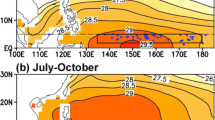Abstract
The genesis potential parameter (GPP) consists of two dynamical variables low-level relative vorticity and vertical wind shear, and two thermodynamic variables middle tropospheric relative humidity and instability are analysed during pre-cyclone watch period over the Bay of Bengal. The pre-cyclone watch period is taken as the period prior to 72-h from the formation of a Depression. The GPP values for 30 tropical disturbances that formed over the Bay of Bengal during the period 2001–2010 are analysed. An independent evaluation of the parameter and possible applications to operational forecasting are presented using data from the year 1998 to 1999. The variables of GPP are calculated using the ECMWF interim reanalysis 1.5° × 1.5° resolution data, averaged within an area of 5° × 5° box on the centre of tropical disturbances and also over the 5° × 5° boxes over the adjacent surrounding areas. The results show that maximum value is observed over the genesis region at 48- and 24-h lead time for both the cases of cyclones and Depressions. The threshold value of GPP is found to be 9.3, 6.3 and 2.7 during pre-cyclone watch period at 24-, 48- and 72-h lead time, respectively. A distinction in GPP values above threshold value for cyclonic and a Depression system is also observed for the cyclogenesis region in 69, 75 and 75 % of cases at 72-, 48- and 24-h lead time, respectively. However, the individual case studies show that the GPP could indicate the genesis of a tropical cyclone with a 2-day lead time. The mean GPP values are 11.8, 8.5 and 3.8 for cyclonic systems and 6.9, 4.2 and 1.6 for Depression systems over an area of a box 5° × 5° on the systems at 24-, 48- and 72-h lead time, respectively, from the stage of Depression. The result of the study is found to be providing probable area of genesis and intensification of a tropical disturbance at a 2 day lead time from the stage Depression.





Similar content being viewed by others
References
Camargo SJ, Emanuel KA, Sobel AH (2007) Use of a genesis potential index to diagnose ENSO effects on tropical cyclone genesis. J Clim 20:4819–4834
DeMaria M, Knaff JA, Bernadette HC (2001) A tropical cyclone genesis parameter for the tropical Atlantic. Wea Forecast 16:219–233
Dvorak VF (1975) Tropical cyclone intensity analysis and forecasting from satellite imagery. Mon Wea Rev 103:420–430
Elsberry RL, Jeffries R (1996) Vertical wind shear influences on tropical cyclone formation and intensification during TCM-92 and TCM-93. Mon Wea Rev 124:1374–1387
Gray WM (1968) Global view of the origin of tropical disturbances and storms. Mon Wea Rev 96:669–700
Gray WM (1978) Hurricane and their formation structure and likely role in the tropical circulation. Prepared for the RMS/AMS conference on met. over the tropical oceans, London, August 21–25 1978 and RMS conference volume
Kalsi SR, Srivastava KB (2006) Characteristic features of Orissa super cyclone of 29th October, 1999 as observed through CDR Paradip. Mausam (New Delhi) 57:21–30
Kotal SD, Roy Bhowmik SK, Kundu PK, Das AK (2008) A statistical cyclone intensity prediction (SCIP) model for Bay of Bengal. J Earth Syst Sci 117:157–168
Kotal SD, Kundu PK, Roy Bhowmik SK (2009) Analysis of cyclogenesis parameter for developing and nondeveloping low-pressure systems over the Indian Sea. Nat Hazards 50:389–402
Mandal GS, Rao AVRK, Gupta SC (1981) Characteristics of an Arabian Sea cyclone. Mausam (New Delhi) 32:139–144
McBride JL, Zehr RM (1981) Observational analysis of tropical cyclone formation. Part II: comparison of non-developing versus developing systems. J Atmos Sci 38:1132–1151
Mohapatra M, Bandhyopadhya BK, Ajit T (2011) Best track parameters of tropical cyclones over the North Indian Ocean: a review. Nat Hazards. doi:10.1007/s11069-011-9935-0
Palmen EN (1948) On the formation and structure of the tropical hurricane. Geophysica 3:26–38
Riehl H (1948) On the formation of typhoons. J Meteor 5:247–264
Roy Bhowmik SK (2003) An evaluation of cyclone genesis parameter over the Bay of Bengal using model analysis. Mausam (New Delhi) 54:351–358
Roy Bhowmik SK, Kotal SD, Kalsi SR (2007) An empirical model for predicting intensity of tropical cyclone over the Bay of Bengal. Nat Hazards 41:447–455
Royer J-F, Chauvin F, Timbal B, Araspin P, Grimal D (1998) A GCM study of the impact of greenhouse gas increase on the frequency of occurrence of tropical cyclone. Clim Change 38:307–343
Acknowledgments
The authors are grateful to the Director General of Meteorology, India Meteorological Department, New Delhi for providing all the facilities to carry out this research work. The authors acknowledge the use of ECMWF data in this research work and are grateful to the anonymous reviewers for their valuable comments to improve the quality of the paper.
Author information
Authors and Affiliations
Corresponding author
Rights and permissions
About this article
Cite this article
Nath, S., Kotal, S.D. & Kundu, P.K. Analysis of a genesis potential parameter during pre-cyclone watch period over the Bay of Bengal. Nat Hazards 65, 2253–2265 (2013). https://doi.org/10.1007/s11069-012-0473-1
Received:
Accepted:
Published:
Issue Date:
DOI: https://doi.org/10.1007/s11069-012-0473-1



